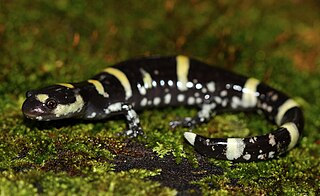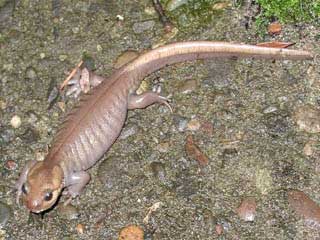
Salamanders are a group of amphibians typically characterized by their lizard-like appearance, with slender bodies, blunt snouts, short limbs projecting at right angles to the body, and the presence of a tail in both larvae and adults. All ten extant salamander families are grouped together under the order Urodela from the group Caudata. Salamander diversity is highest in eastern North America, especially in the Appalachian Mountains; most species are found in the Holarctic realm, with some species present in the Neotropical realm.

The mole salamanders are a group of advanced salamanders endemic to North America. The group has become famous due to the presence of the axolotl, widely used in research due to its paedomorphosis, and the tiger salamander which is the official amphibian of many US states, and often sold as a pet.

The tiger salamander is a species of mole salamander and one of the largest terrestrial salamanders in North America.

The California tiger salamander is a vulnerable amphibian native to California. It is a mole salamander. Previously considered to be a subspecies of the tiger salamander, the California tiger salamander was recently designated a separate species again. The California tiger salamander distinct population segment (DPS) in Sonoma County and the Santa Barbara County DPS are listed as federally endangered, while the Central California DPS is listed as federally threatened. The Sonoma County, south San Joaquin, and the Santa Barbara County DPS have diverged from the rest of the California tiger salamander populations for over one million years, since the Pleistocene and they may warrant status as separate species.

The Jefferson salamander is a mole salamander native to the northeastern United States, southern and central Ontario, and southwestern Quebec. It was named after Jefferson College in Pennsylvania.

The ringed salamander is a species of mole salamander native to hardwood and mixed hardwood-pine forested areas in and around the Ozark Plateau and Ouachita Mountains of Arkansas, Oklahoma, and Missouri. This species of salamander has slander body, small head, and long tail. They are usually found to have various dorsal color from dark gray to dark brown. Various close relatives are found such as marbled salamander and spotted salamander. This species of salamander has cannibal behavior especially those in large body size.

The frosted flatwoods salamander is an endangered salamander species native to the Southeastern United States.

The northwestern salamander is a species of mole salamander that inhabits the northwest Pacific coast of North America. These fairly large salamanders grow to 8.7 in (220 mm) in length. It is found from southeastern Alaska on May Island, through Washington and Oregon south to the mouth of the Gualala River, Sonoma County, California. It occurs from sea level to the timberline, but not east of the Cascade Divide. Its range includes Vancouver Island in British Columbia and The San Juan Islands, Cypress, Whidbey, Bainbridge, and Vashon Islands in Washington.

The long-toed salamander is a mole salamander in the family Ambystomatidae. This species, typically 4.1–8.9 cm (1.6–3.5 in) long when mature, is characterized by its mottled black, brown, and yellow pigmentation, and its long outer fourth toe on the hind limbs. Analysis of fossil records, genetics, and biogeography suggest A. macrodactylum and A. laterale are descended from a common ancestor that gained access to the western Cordillera with the loss of the mid-continental seaway toward the Paleocene.

Taylor's salamander is a species of salamander found only in Laguna Alchichica, a high-altitude crater lake to the southwest of Perote, Mexico. It was first described in 1982 but had been known to science prior to that. It is a neotenic salamander, breeding while still in the larval state and not undergoing metamorphosis. The lake in which it lives is becoming increasingly saline and less suitable for the salamander, which is declining in numbers. The International Union for Conservation of Nature (IUCN) has rated it as being "critically endangered".

Anderson's salamander is a neotenic salamander from Zacapu Lagoon in the Mexican state of Michoacán.

The Lake Patzcuaro salamander, locally known as achoque, is a paedomorphic species of salamander found exclusively in Lake Pátzcuaro, a high-altitude lake in the Mexican state of Michoacán. First described in 1870 by Alfredo Dugès, the species is named in honor of the French herpetologist Auguste Duméril. However, the salamander has been used as a food source and an ingredient in traditional medicines by the Purépecha people since the Pre-Columbian era. Ambystoma dumerilii are neotenic, meaning they retain their larval characteristics throughout their entire life. This results in adults that have long, heavily filamented external gills, gill slits lined with tooth-like gill rakers, and caudal fins. When stressed, Ambystoma dumerilii can undergo an incomplete metamorphosis, though this is process significantly decreases their lifespan and is often fatal.

The marbled salamander is a species of mole salamander found in the eastern United States.
The Puerto Hondo stream salamander or Michoacan stream salamander is a mole salamander from the Trans-Mexican Volcanic Belt within the Mexican state of Michoacán.

The yellow-peppered salamander also known as the salamandra de Champala and the yellow-headed salamander, is a species of mole salamander native to areas at an elevation of 4900 ft around Santa Cruz, Rancho Malveste and Tapalpa in Jalisco, Mexico.

The lesser siren is a species of aquatic salamander native to the eastern United States and northern Mexico. They are referred to by numerous common names, including two-legged eel, dwarf siren, and mud eel. The specific epithet intermedia denotes their intermediate size, between the greater siren, Siren lacertina, and the dwarf sirens, Pseudobranchus species.

The small-mouth salamander is a species of mole salamander found in the central United States, from the Great Lakes region in Michigan to Nebraska, south to Texas, and east to Tennessee, with a population in Canada, in Pelee, Ontario. It is sometimes referred to as the Texas salamander, porphyry salamander, or the narrow-mouthed salamander. The Kelley's Island salamander was synonymized with A. texanum in 1995.

Ambystoma talpoideum, the mole salamander, is a species of salamander found in much of the eastern and central United States, from Florida to Texas, north to Illinois, east to Kentucky, with isolated populations in Virginia and Indiana. Older sources often refer to this species as the tadpole salamander because some individuals remain in a neotenic state. This salamander lives among the leaf litter on the forest floor, migrating to ponds to breed.

The barred tiger salamander or western tiger salamander is a species of mole salamander that lives in lower western Canada, the western United States and northern Mexico.

The Tarahumara salamander is a freshwater species of mole salamander in the family Ambystomatidae, endemic to Mexico. Its natural habitats are temperate forest, subtropical or tropical moist montane forest, subtropical or tropical high-altitude grassland, rivers, freshwater marshes, pastureland, and ponds.



















